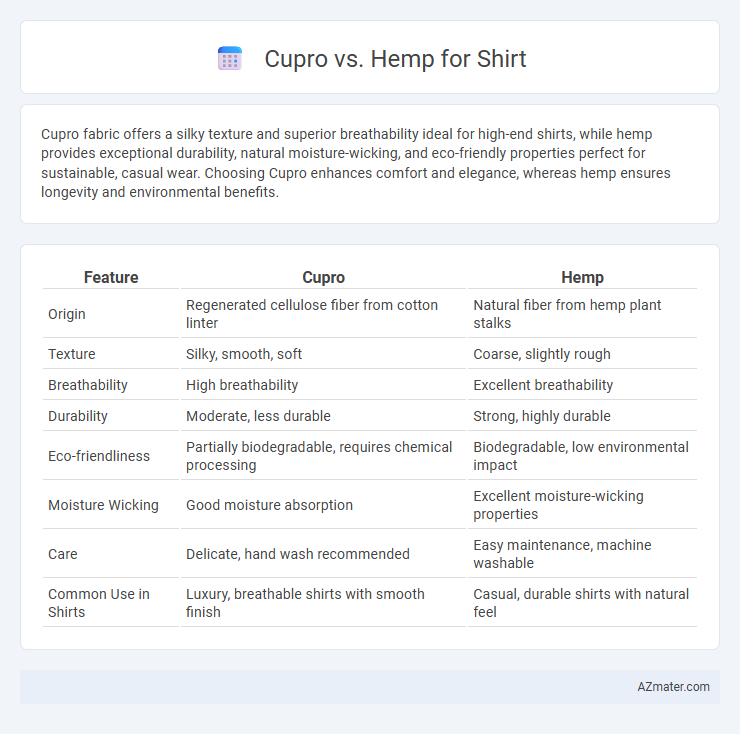Cupro fabric offers a silky texture and superior breathability ideal for high-end shirts, while hemp provides exceptional durability, natural moisture-wicking, and eco-friendly properties perfect for sustainable, casual wear. Choosing Cupro enhances comfort and elegance, whereas hemp ensures longevity and environmental benefits.
Table of Comparison
| Feature | Cupro | Hemp |
|---|---|---|
| Origin | Regenerated cellulose fiber from cotton linter | Natural fiber from hemp plant stalks |
| Texture | Silky, smooth, soft | Coarse, slightly rough |
| Breathability | High breathability | Excellent breathability |
| Durability | Moderate, less durable | Strong, highly durable |
| Eco-friendliness | Partially biodegradable, requires chemical processing | Biodegradable, low environmental impact |
| Moisture Wicking | Good moisture absorption | Excellent moisture-wicking properties |
| Care | Delicate, hand wash recommended | Easy maintenance, machine washable |
| Common Use in Shirts | Luxury, breathable shirts with smooth finish | Casual, durable shirts with natural feel |
Introduction to Cupro and Hemp Fabrics
Cupro fabric is a regenerated cellulose fiber derived from cotton linter, known for its silky texture, breathability, and eco-friendly production process that utilizes cotton waste. Hemp fabric, made from the fibers of the hemp plant, offers exceptional durability, natural antibacterial properties, and superior moisture-wicking capabilities, making it a sustainable choice for shirts. Both materials are biodegradable and require less water and pesticides compared to conventional cotton, appealing to environmentally conscious consumers seeking comfortable and stylish apparel.
Origins and Production Processes
Cupro is a regenerated cellulose fiber derived from cotton linter, utilizing a chemical process that dissolves cellulose and regenerates it into fine, silky fabric. Hemp originates from the Cannabis sativa plant and undergoes mechanical extraction followed by retting, decortication, and fiber processing, resulting in durable and breathable textiles. The production of Cupro involves significant chemical treatment, whereas hemp processing relies more on natural, environmentally friendly methods with minimal chemical use.
Sustainability and Environmental Impact
Cupro, a regenerated cellulose fiber derived from cotton linter waste, offers a sustainable alternative due to its use of agricultural byproducts and biodegradability, reducing textile waste and chemical use compared to traditional fabrics. Hemp, known for its rapid growth and minimal resource needs, excels in carbon sequestration and requires significantly less water and pesticides than cotton, making it an environmentally friendly choice for shirts with a low ecological footprint. Both fibers support eco-conscious fashion by promoting circular economy principles and reducing reliance on petroleum-based materials, but hemp's cultivation advantages often lead to a lower overall environmental impact than Cupro processing.
Fabric Feel and Texture Comparison
Cupro fabric offers a silky, smooth texture with a luxurious drape, providing a soft and breathable feel ideal for lightweight, elegant shirts. Hemp fabric has a coarser, more textured surface that softens with wear, delivering durability and a natural, slightly rugged aesthetic suited for casual or eco-conscious apparel. Both fibers are breathable and moisture-wicking, but Cupro excels in silk-like softness while Hemp stands out for its sturdiness and organic texture.
Breathability and Comfort
Cupro fabric offers exceptional breathability due to its moisture-wicking properties, making it ideal for comfortable, cool shirts in warm climates. Hemp fibers provide excellent airflow and durability, ensuring long-lasting comfort and natural temperature regulation. Both materials excel in breathability, but Cupro delivers a smoother, silk-like feel while Hemp offers eco-friendly robustness.
Durability and Longevity
Cupro fabric, made from regenerated cellulose fibers derived from cotton linter, offers moderate durability with a smooth texture but tends to wear down faster under frequent washing and heavy use compared to hemp. Hemp fibers are exceptionally strong and resistant to abrasion, making hemp shirts highly durable and long-lasting with enhanced breathability and mildew resistance. Choosing hemp for shirts ensures greater longevity and sustained fabric integrity over time, especially in demanding wear conditions.
Color Retention and Dyeing Capabilities
Cupro fabric exhibits excellent color retention due to its smooth cellulose fibers that absorb dyes evenly, resulting in vibrant and long-lasting hues. Hemp fibers, although naturally coarse, offer good dyeing capabilities with a matte finish but may fade faster over time compared to cupro. Both materials support eco-friendly dye processes, but cupro's superior dye uptake makes it preferable for shirts requiring intense and durable coloration.
Maintenance and Care Instructions
Cupro shirts require gentle washing with mild detergent and should be air-dried flat to maintain their silky texture, avoiding direct sunlight to prevent discoloration. Hemp shirts, known for durability, can be machine washed on a gentle cycle with cold water but benefit from air drying to preserve fiber strength and prevent shrinkage. Both fabrics respond well to low-heat ironing, but Cupro is more sensitive to high temperatures compared to the sturdier hemp material.
Style Versatility and Fashion Trends
Cupro fabric offers a silky, smooth texture that enhances the drape and elegance of shirts, making it ideal for stylish, versatile pieces that seamlessly transition from casual to formal wear. Hemp fabric provides a more textured, natural look with excellent breathability, aligning with sustainable fashion trends and appealing to eco-conscious consumers seeking rugged yet refined styles. Fashion trends increasingly favor Cupro for its luxurious feel in contemporary designs, while Hemp gains popularity in relaxed, earthy aesthetics promoting durability and environmental responsibility.
Price and Availability Comparison
Cupro shirts generally have a higher price point due to the complex production process involving regenerated cellulose fibers derived from cotton linter. Hemp shirts are often more affordable and widely available, benefiting from the plant's rapid growth and lower cultivation costs. Availability of hemp clothing is expanding rapidly as sustainable fashion gains traction, whereas cupro remains a niche fabric found in premium or eco-conscious brands.

Infographic: Cupro vs Hemp for Shirt
 azmater.com
azmater.com